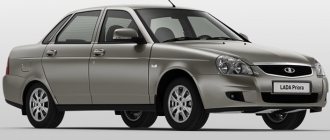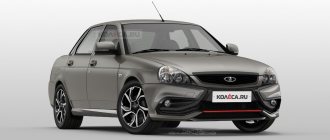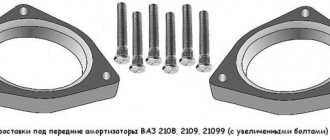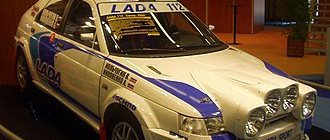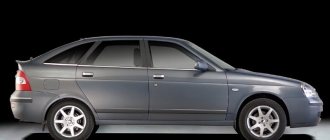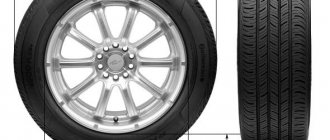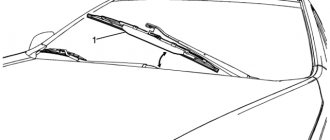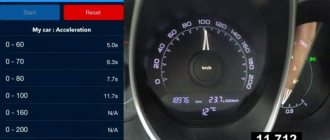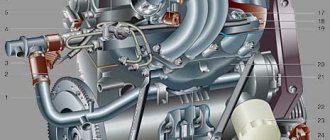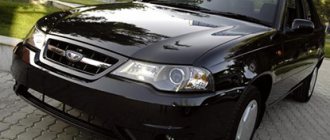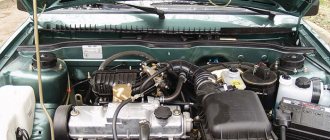| Modification | Maximum torque, N*m | Engine make |
| 1.5 l, 68 hp, gasoline, manual transmission, front-wheel drive | 103 | -2103 |
| 1.5 l, 70 hp, gasoline, manual transmission, front-wheel drive | 104 | -21083 |
| 1.5 l, 76 hp, gasoline, manual transmission, front-wheel drive | 106 | -21083 |
| 1.5 l, 78 hp, gasoline, manual transmission, front-wheel drive | 115 | -2111 |
| 1.6 l, 80 hp, gasoline, manual transmission, front-wheel drive | 120 | -21114 |
| 1.6 l, 81 hp, gasoline, manual transmission, front-wheel drive | 120 | -11183 |
Lada 2115 body dimensions dimensions
The length of the VAZ 2115 body is 4330 (mm), width - 1650 (mm), height ranges from 1402 to 1420 (mm).
VAZ 2115 (Lada Samara 2) is a subcompact front-wheel drive car in a sedan body, produced by Russia from 1997 to 2012.
In total, one generation and 6 modifications were developed for this VAZ model.
Dimensions of the VAZ 2115/21154 1.6 MT sedan:
- Length: 4330 (mm);
- Width: 1650 (mm);
- Height: 1420 (mm);
- Wheelbase: 2460 (mm);
- Ground clearance: 170 (mm).
The ground clearance (clearance) for all modifications of the VAZ 2115 is the same 170 (mm).
Important: the wheelbase is the distance between the central points of the front and rear wheels; the VAZ 2115 sedan has a wheelbase of 2460 (mm).
The subcompact sedan VAZ 2115 was known on the Russian market under the name Lada Samara 2.
Important: years of production of all modifications of the model: 1997-2012.
| General view General view of the body |
Caution: The above data are the official figures of the manufacturer, however, please note that the information is for reference only and is not guaranteed to be completely accurate.
Source
A little history
In the period from 1980 to 1984, AvtoVAZ worked quite closely with the giant of the modern automotive industry - Porsche.
At that time, joint work was underway on the VAZ 2108 model. Already in the period from 1987 to 1991, the companies began working on a new car - the VAZ 2110 with a 1.5-liter engine.
Despite the cooperation agreement regarding only these two models, specialists did not miss the opportunity to work on the entire line being developed at that time. This also applied to the VAZ 2109 model, which became the successor to the modern fourteenth.
Not everyone knows about this fact of cooperation with a German company, which was already considered a model of the automotive industry. But this is precisely what served as a springboard for the creation of reliable and very interesting domestic cars.
Large-scale production of the successor to the Russian-German “nine” in the person of the VAZ 2114 began in 2003. It is noteworthy that first, in 2001, the VAZ 2115 appeared, and in 2004, the VAZ 2113.
According to research, the VAZ 2114 is on the list of the most common models in Russia.
Differences from the “nine”
There are not so many differences between the VAZ 2114 and VAZ 2109 in terms of bodywork. The updated car received new:
There were much more changes inside. But in many ways the difference is determined by the class of the car, that is, its equipment. For the VAZ 2114 there were three equipment options - Standard, Norma and Lux.
So what has changed inside?
Key Benefits
Obviously, the fourteenth model from AvtoVAZ is not as simple as many people think at first glance. Otherwise, it simply would not have been so popular and in demand.
Here's an example of a few of the most significant benefits.
Source
VAZ 2115 dimensions and weight
Body dimensions are one of the most important parameters when choosing a car. The larger the car, the more difficult it is to drive in a modern city, but also the safer. The overall dimensions of the Lada 2115 Samara are determined by three dimensions: body length, body width and body height. Typically, the length is measured from the most forward point of the front bumper to the farthest point of the rear bumper. The width of the body is measured at the widest point: as a rule, these are either the wheel arches or the central pillars of the body. But with height, not everything is so simple: it is measured from the ground to the roof of the car; The height of the roof rails is not included in the overall height of the body.
Overall dimensions of the Lada 2115 Samara are from 4330 x 1620 x 1415 to 4330 x 1650 x 1415 mm, and the weight is from 970 to 1000 kg.
Dimensions Lada 2115 Samara 1997, sedan, 1st generation
| Options | Dimensions | Weight, kg |
| 1.5 MT Basic | 4330 x 1620 x 1415 | 970 |
| 1.5i MT Base | 4330 x 1620 x 1415 | 970 |
| 1.6MT0 | 4330 x 1650 x 1415 | 1000 |
| 1.6MT0 | 4330 x 1650 x 1415 | 1000 |
| 1.6MT0 | 4330 x 1650 x 1415 | 1000 |
| 1.6MT0 | 4330 x 1650 x 1415 | 1000 |
| 1.6MT2 | 4330 x 1650 x 1415 | 1000 |
| 1.6 MT Lux0 | 4330 x 1650 x 1415 | 1000 |
| 1.6 MT Standard2 | 4330 x 1650 x 1415 | 1000 |
Precautions when tuning the “fourteenth”
When increasing the ground clearance of the VAZ 2114, moderation should be observed. It is still possible to increase the clearance by 5 centimeters, but by 10 it is no longer worth it. The fact is that by carrying out such tuning, you make noticeable changes to the design of the car. This is due to the raising of the vehicle's center of gravity (CG).
The standard height of the CG of a car without tuning above the road surface is 56 cm. The weight of the car is about 50 kg. Calculations show that raising the car by 5 cm is similar to placing a load of approximately 40 kilograms on the roof of your “fourteenth”. So imagine that you are entering a turn at a speed of 90 km/h with a couple of heavy bags of potatoes on the roof rack. You will closely simulate the behavior of a car with increased ground clearance in a high-speed turn.
Before you start tuning, evaluate again how often you have to climb curbs exactly 19 centimeters high and drive through cutting areas between stumps exactly 18 to 22 centimeters high. Maybe you shouldn’t fence your garden... Be careful, take care of yourself.
There is less danger in lowering the car due to the use of shorter shock-absorbing elements, but even in this case it is necessary to take care of the compatibility of the tuning elements with the basic design. Low springs can be dangerous when hitting an obstacle.
How many seats in VAZ 2115
Passenger cars have 5 and 7 seats. There are, of course, modifications with two, three and six seats, but these are quite rare cases. In most cases, we are talking about five or seven seats: two in the front, three in the back, and two more in the trunk area. Seven seats in the cabin are usually an option: that is, the car is initially designed for 5 seats, and then two additional small seats are installed in the cabin; they are compactly mounted in the trunk area.
The Lada 2115 Samara car has 5 seats.
How many seats in Lada 2115 Samara 1997, sedan, 1st generation
| Options | Number of seats |
| 1.5 MT Basic | 5 |
| 1.5i MT Base | 5 |
| 1.6MT0 | 5 |
| 1.6MT0 | 5 |
| 1.6MT0 | 5 |
| 1.6MT0 | 5 |
| 1.6MT2 | 5 |
| 1.6 MT Lux0 | 5 |
| 1.6 MT Standard2 | 5 |
Trunk volume of VAZ 2115
The spacious trunk will come in handy around the house. Many car enthusiasts, when deciding to buy a car, consider trunk capacity as one of the first things they look at. 300-500 liters - these are the most common volume values for modern cars. If you can fold the rear seats, the trunk will increase even more.
The trunk on the Lada 2115 Samara is from 427 to 445 liters, depending on the configuration.
Trunk volume Lada 2115 Samara 1997, sedan, 1st generation
| Options | Trunk capacity, l |
| 1.5 MT Basic | 427 |
| 1.5i MT Base | 427 |
| 1.6MT0 | 445 |
| 1.6MT0 | 445 |
| 1.6MT0 | 445 |
| 1.6MT0 | 445 |
| 1.6MT2 | 445 |
| 1.6 MT Lux0 | 445 |
| 1.6 MT Standard2 | 445 |
Changes
Overall, despite some similarities, the 2115 has a significantly more modern design. This was largely due to the presence of bumpers and other external elements made of plastic. All of them help protect the body from minor damage and the negative effects of corrosion.
The most notable innovations in this model are the following:
- additional brake signal installed directly on the spoiler;
- new rear lights;
- highly reliable security system;
- a tailgate sill that allowed the loading height to be reduced;
- more streamlined body geometry;
- door moldings;
- modern electrical equipment.
At the time the design was completed, the VAZ-2115 was a modern and quite beautiful car. At the same time, its interior turned out to be much more comfortable than that of the old models of the Volzhsky Automobile Plant. The driver was able to regulate:
- steering wheel height;
- seat position, etc.
The designers installed a console between the front seats. The heating system and the ECU also turned out to be more advanced. Moreover, the trunk of the model in question is much more spacious than its predecessors.
The designers borrowed many elements from the 2114, while many devices and components were inherited from the G8. For example, the chassis has migrated unchanged to the new sedan.
What drive does the VAZ 2115 have?
The Lada 2115 Samara is equipped with the following types of drive: Front-wheel drive (FF). Let's figure out which type of drive is best for a car.
There are only three types of drive. Front-wheel drive (FF) - when torque from the engine is transmitted only to the front wheels. All-wheel drive (4WD) - when the torque is distributed to the wheels of both the front and rear axles. And also Rear-wheel drive (FR), in its case, all the engine power is completely given to the two rear wheels.
Front-wheel drive is “safer”, front-wheel drive cars are easier to control and more predictable in motion, even a beginner can handle them. Therefore, most modern cars are equipped with front-wheel drive. In addition, it is inexpensive and requires less attention to maintain.
All-wheel drive can be called an advantage of any car. 4WD increases the vehicle's cross-country ability and allows its owner to feel confident both in winter on snow and ice, and in summer on sand and mud. However, you will have to pay for the pleasure, both in increased fuel consumption and in the price of the car itself - cars with a 4WD drive type are more expensive than other options.
As for rear-wheel drive, in the modern automotive industry it is equipped with either sports cars or budget SUVs.
Drive Lada 2115 Samara 1997, sedan, 1st generation
| Options | type of drive |
| 1.5 MT Basic | Front (FF) |
| 1.5i MT Base | Front (FF) |
| 1.6MT0 | Front (FF) |
| 1.6MT0 | Front (FF) |
| 1.6MT0 | Front (FF) |
| 1.6MT0 | Front (FF) |
| 1.6MT2 | Front (FF) |
| 1.6 MT Lux0 | Front (FF) |
| 1.6 MT Standard2 | Front (FF) |
Improved aerodynamics
The VAZ 2114 car excels in aerodynamic characteristics thanks to its well-designed body lines, providing excellent streamlining. As a result of the change in appearance, the drag coefficient has decreased.
External aerodynamic improvements of the Lada2114Samara-2 also affected changes in the position of the air flow separation point. To do this, the designers had to change the angle of inclination of the most aerodynamically active front part of the car - the hood. The front fenders have also undergone changes.
As a result of the redistribution of the air flow, a smaller part of it is directed under the bottom, while the larger part is directed onto the hood and spreads over the body. These characteristics change the amount of total lift force, as a result of which the front and rear axles are unloaded. The even distribution of lift force allows the hatchback to behave in a balanced manner during high-speed driving.
Ground clearance VAZ 2115
Ground clearance is the distance from the lowest point in the center of the car body to the ground. However, the manufacturer of the Lada 2115 Samara measures the ground clearance as it suits him. This means that the distance from the shock absorbers, engine oil pan or muffler to the asphalt may be less than the stated ground clearance.
An interesting point: car buyers pay special attention to ground clearance, because in our country good ground clearance is a necessity; it will save you from headaches when parking to curbs.
The ground clearance height of the Lada 2115 Samara is 170 mm. But be careful when going on vacation or returning with shopping: a loaded car will easily lose 2-3 centimeters of ground clearance.
If desired, the ground clearance of any car can be increased using spacers for shock absorbers. The car will become taller. However, it will lose its former stability at high speeds and will lose greatly in maneuverability. The ground clearance can also be reduced; for this, as a rule, it is enough to replace the standard shock absorbers with tuning ones: the handling and stability will immediately please you.
Ground clearance Lada 2115 Samara 1997, sedan, 1st generation
| Options | Ground clearance, mm |
| 1.5 MT Basic | 170 |
| 1.5i MT Base | 170 |
| 1.6MT0 | 170 |
| 1.6MT0 | 170 |
| 1.6MT0 | 170 |
| 1.6MT0 | 170 |
| 1.6MT2 | 170 |
| 1.6 MT Lux0 | 170 |
| 1.6 MT Standard2 | 170 |
Precautions when tuning the “fourteenth”
When increasing the ground clearance of the VAZ 2114, moderation should be observed. It is still possible to increase the clearance by 5 centimeters, but by 10 it is no longer worth it. The fact is that by carrying out such tuning, you make noticeable changes to the design of the car. This is due to the raising of the vehicle's center of gravity (CG).
The standard height of the CG of a car without tuning above the road surface is 56 cm. The weight of the car is about 50 kg. Calculations show that raising the car by 5 cm is similar to placing a load of approximately 40 kilograms on the roof of your “fourteenth”. So imagine that you are entering a turn at a speed of 90 km/h with a couple of heavy bags of potatoes on the roof rack. You will closely simulate the behavior of a car with increased ground clearance in a high-speed turn.
Before you start tuning, evaluate again how often you have to climb curbs exactly 19 centimeters high and drive through cutting areas between stumps exactly 18 to 22 centimeters high. Maybe you shouldn’t fence your garden... Be careful, take care of yourself.
There is less danger in lowering the car due to the use of shorter shock-absorbing elements, but even in this case it is necessary to take care of the compatibility of the tuning elements with the basic design. Low springs can be dangerous when hitting an obstacle.
Transmission VAZ 2115
What to choose when buying a car: automatic, manual or CVT? And there are also robots! An automatic transmission is more expensive, but for this money the driver gets comfort and does not get nervous in traffic jams. A manual transmission is cheaper, its advantages are ease of maintenance and durability. As for the CVT, its strong point is fuel economy, but the reliability of CVTs is not yet up to par. As a rule, no one speaks well of a robot. A robot is a compromise between an automatic and a manual, and like any compromise, it has more minuses than pluses.
Lada 2115 Samara is available with the following types of transmission: Manual transmission.
Transmission Lada 2115 Samara 1997, sedan, 1st generation
| Modifications | Transmission type |
| 1.5 l, 68 hp, gasoline, front-wheel drive | Manual transmission 5 |
| 1.5 l, 70 hp, gasoline, front-wheel drive | Manual transmission 5 |
| 1.5 l, 76 hp, gasoline, front-wheel drive | Manual transmission 5 |
| 1.5 l, 78 hp, gasoline, front-wheel drive | Manual transmission 5 |
| 1.6 l, 80 hp, gasoline, front-wheel drive | Manual transmission 5 |
| 1.6 l, 81 hp, gasoline, front-wheel drive | Manual transmission 5 |
conclusions
Selecting and installing a spacer for VAZ-2114 shock absorbers to increase ground clearance is quite simple. Even a novice motorist can cope with this task.
Wheel spacers (or wheel spacers) are an attribute of the sporty style of a car. Installing spacers under the wheels allows you to increase the wheelbase of the car, give it a more aggressive and sporty appearance, as well as improve driving dynamics, stability and controllability of the car.
Fuel consumption VAZ 2115
There is no car enthusiast who would not be concerned about the fuel consumption of his car. A psychologically important mark is the value of 10 liters per hundred. If the consumption is less than ten liters, then this is considered good, but if it is higher, then it requires explanation. In the last few years, fuel consumption of about 6 liters per 100 km has been considered optimal in terms of economy.
Fuel consumption of the Lada 2115 Samara ranges from 7.3 to 7.8 liters per 100 km.
Lada 2115 Samara is available with the following types of fuel: Gasoline AI-92, Gasoline AI-95.
Fuel consumption Lada 2115 Samara 1997, sedan, 1st generation
| Modification | Fuel consumption, l/100 km | Fuel used |
| 1.5 l, 78 hp, gasoline, manual transmission, front-wheel drive | 7,3 | Gasoline AI-95 |
| 1.6 l, 81 hp, gasoline, manual transmission, front-wheel drive | 7,6 | Gasoline AI-95 |
| 1.6 l, 80 hp, gasoline, manual transmission, front-wheel drive | 7,6 | Gasoline AI-95 |
| 1.5 l, 76 hp, gasoline, manual transmission, front-wheel drive | 7,6 | Gasoline AI-92 |
| 1.5 l, 70 hp, gasoline, manual transmission, front-wheel drive | 7,8 | Gasoline AI-92 |
| 1.5 l, 68 hp, gasoline, manual transmission, front-wheel drive | 7,8 | Gasoline AI-92 |
Tank volume VAZ 2115
The most common fuel tank sizes in cars are 40, 50, 60 and 70 liters. Judging by the volume of the tank, you can tell how big the car is. In the case of a 30 liter tank, we are most likely talking about a small car. 50-60 liters is a sign of a strong middle peasant. And 70 indicates a full-size car.
The volume of the fuel tank would be a useless quantity if it were not for fuel consumption. Knowing the average fuel consumption, you can easily calculate how many kilometers a full tank of fuel will last you. On-board computers of modern cars are able to quickly show this information to the driver.
The fuel tank volume of the Lada 2115 Samara is 43 liters.
Tank volume Lada 2115 Samara 1997, sedan, 1st generation
| Options | Fuel tank volume, l |
| 1.5 MT Basic | 43 |
| 1.5i MT Base | 43 |
| 1.6MT0 | 43 |
| 1.6MT0 | 43 |
| 1.6MT0 | 43 |
| 1.6MT0 | 43 |
| 1.6MT2 | 43 |
| 1.6 MT Lux0 | 43 |
| 1.6 MT Standard2 | 43 |
Acceleration to 100 in Lada 2115 Samara
Acceleration to hundreds is an important indicator of a car's power. The acceleration time to 100 km/h, unlike horsepower and torque, can actually be “touched”. The vast majority of cars accelerate from zero to hundreds in 10-14 seconds. Near-sports and souped-up cars with touring engines and compressors are capable of reaching 100 km/h in 10 seconds or less. Only a few dozen cars in the world are capable of reaching one hundred kilometers per hour in less than 4 seconds. Approximately the same number of production cars accelerate to hundreds in 20 seconds or more.
Acceleration time to 100 km/h Lada 2115 Samara - from 13 to 14 seconds.
Acceleration to 100 in Lada 2115 Samara 1997, sedan, 1st generation
| Modification | Acceleration to 100 km/h |
| 1.5 l, 70 hp, gasoline, manual transmission, front-wheel drive | 13 |
| 1.6 l, 80 hp, gasoline, manual transmission, front-wheel drive | 13 |
| 1.6 l, 81 hp, gasoline, manual transmission, front-wheel drive | 13 |
| 1.5 l, 68 hp, gasoline, manual transmission, front-wheel drive | 13.2 |
| 1.5 l, 76 hp, gasoline, manual transmission, front-wheel drive | 13.2 |
| 1.5 l, 78 hp, gasoline, manual transmission, front-wheel drive | 14 |
VAZ 2115 engine capacity, technical characteristics
The larger the engine capacity, the more powerful the car, and, as a rule, the larger it is. There is no point in installing a small-capacity engine on a large car, the engine simply cannot cope with its weight, and the opposite is also pointless - installing a large engine in a light car. Therefore, manufacturers are trying to match the engine... to the price of the car. The more expensive and prestigious the model, the larger the engine capacity and the more powerful it is. Budget versions rarely boast a cubic capacity of more than two liters.
Engine displacement is expressed in cubic centimeters or liters. Whichever is more convenient for you.
The engine capacity of the Lada 2115 Samara is from 1.5 to 1.6 liters.
Engine power of Lada 2115 Samara is from 68 to 81 hp.
Engine Lada 2115 Samara 1997, sedan, 1st generation
| Modifications | Engine volume, cm³ | Engine make |
| 1.5 l, 68 hp, gasoline, manual transmission, front-wheel drive | 1452 | VAZ-2103 |
| 1.5 l, 70 hp, gasoline, manual transmission, front-wheel drive | 1499 | VAZ-21083 |
| 1.5 l, 76 hp, gasoline, manual transmission, front-wheel drive | 1499 | VAZ-21083 |
| 1.5 l, 78 hp, gasoline, manual transmission, front-wheel drive | 1499 | VAZ-2111 |
| 1.6 l, 80 hp, gasoline, manual transmission, front-wheel drive | 1596 | VAZ-21114 |
| 1.6 l, 81 hp, gasoline, manual transmission, front-wheel drive | 1596 | VAZ-11183 |
Basic Concepts
Body geometry refers to the exact dimensions of the vehicle established by the designers of the manufacturing plant. The main parameters of paramount importance are:
- width – both front and rear tracks;
- length of the wheelbase;
- the distance between the side members and their length.
As practice shows, a violation of one or several of the above-mentioned parameters leads to a noticeable deterioration in terms of vehicle controllability.
The secondary dimensions are as follows:
- door openings;
- windows;
- engine compartment volume;
- trunk capacity;
- car interior size.
If these standards are violated, this only leads to a deterioration in the appearance of the vehicle.
A track is the distance between coaxial wheels. Moreover, this distance is measured from point to point, which are located in the center of the tread.
In turn, the wheelbase is the distance between the axles of the car. The control points here are the middle of the hubs.
Torque VAZ 2115
Torque. This is the force with which a car engine turns the crankshaft. The force of torque is traditionally measured either in kilonewtons, which is more accurate from a physics point of view, or in kilograms per meter, which is more familiar to us. Plenty of torque means quick starts and quick acceleration. And the low point is that the car is not a race, but just a car. Again, you need to look at the weight of the car; a massive car needs serious torque, while a light car will live just fine without it.
The torque of the Lada 2115 Samara ranges from 103 to 120 N*m.
Torque Lada 2115 Samara 1997, sedan, 1st generation
| Modification | Maximum torque, N*m | Engine make |
| 1.5 l, 68 hp, gasoline, manual transmission, front-wheel drive | 103 | -2103 |
| 1.5 l, 70 hp, gasoline, manual transmission, front-wheel drive | 104 | -21083 |
| 1.5 l, 76 hp, gasoline, manual transmission, front-wheel drive | 106 | -21083 |
| 1.5 l, 78 hp, gasoline, manual transmission, front-wheel drive | 115 | -2111 |
| 1.6 l, 80 hp, gasoline, manual transmission, front-wheel drive | 120 | -21114 |
| 1.6 l, 81 hp, gasoline, manual transmission, front-wheel drive | 120 | -11183 |
Description and characteristics of the VAZ-2115
The model of this car was developed in 1994, it was supposed to replace the VAZ-21099. But due to the difficult economic situation, production of the VAZ2115 car began only in 1996. Production was carried out in small batches and almost all cars were exported. By that time, the appearance of the car was modern. The appearance was somewhat spoiled by the poorly thought-out sill fairing. Its goal was to reduce aerodynamic drag, but in appearance it resembled a flaw of novice tuners.
In 2001, the VAZ-2115 began to be assembled on an assembly line. Until 2001, it was almost impossible to buy a VAZ2115; the car was very popular and it was prestigious to drive.
What changes were made to the VAZ 2115 compared to the VAZ 21099 in appearance:
- the shape of the front and rear bumpers has been changed;
- bumpers were painted in body color;
- sill fairing;
- door moldings;
- the shape of the hood has been changed;
- the headlights have become narrower;
- new taillights;
- wing on the trunk lid;
- alloy wheels;
- shape of the front wings;
- trunk lid;
Inside the car:
- height-adjustable steering column;
- new instrument panel;
- heated seats;
- power windows for front doors;
- on-board control system;
- The first small-scale cars, produced from 1996 to 2001, were equipped with a 1.5-liter carburetor engine. This is the engine that was on the V8s.
- Since 2001, when production moved to the factory assembly line, a 1.5-liter engine with distributed fuel injection began to be installed on the VAZ2115 car.
- Since 2007, a 1.6-liter injection engine has been installed.
- The car was produced until 2012 inclusive.
Size, weight, speed, acceleration to 100 km/h
| L min (mm) Minimum overall vehicle length for different modifications of the VAZ model Measured in millimeters (mm) | L max (mm) Maximum overall length of the vehicle for different modifications of the VAZ model Measured in millimeters (mm) | n Number of model modifications in our database | Value Parameter value either in (mm) or other units |
| 2115 1.5 MT (1997 - 2000) | |||
| Number of doors | 4 | ||
| Number of seats | 5 | ||
| Wheelbase | 2460 (mm) | ||
| Front track | 1400 (mm) | ||
| Rear track | 1370 (mm) | ||
| Ground clearance | 170 (mm) | ||
| Width | 1650 (mm) | ||
| Length | 4330 (mm) | ||
| Height | 1415 (mm) | ||
| 2115-20 1.5 MT (2000 - 2012) | |||
| Number of doors | 4 | ||
| Number of seats | 5 | ||
| Wheelbase | 2460 (mm) | ||
| Front track | 1400 (mm) | ||
| Rear track | 1370 (mm) | ||
| Ground clearance | 170 (mm) | ||
| Width | 1650 (mm) | ||
| Length | 4330 (mm) | ||
| Height | 1415 (mm) | ||
| 2115-40 1.6 MT (2003 - 2012) | |||
| Number of doors | 4 | ||
| Number of seats | 5 | ||
| Wheelbase | 2460 (mm) | ||
| Front track | 1400 (mm) | ||
| Rear track | 1370 (mm) | ||
| Ground clearance | 170 (mm) | ||
| Width | 1650 (mm) | ||
| Length | 4330 (mm) | ||
| Height | 1402 (mm) | ||
| 2115-91 1.3 MT (2001 - 2012) | |||
| Number of doors | 4 | ||
| Number of seats | 5 | ||
| Wheelbase | 2460 (mm) | ||
| Front track | 1400 (mm) | ||
| Rear track | 1370 (mm) | ||
| Ground clearance | 170 (mm) | ||
| Width | 1650 (mm) | ||
| Length | 4330 (mm) | ||
| Height | 1402 (mm) | ||
| 21150 1.5 MT (1998 - 2000) | |||
| Number of doors | 4 | ||
| Number of seats | 5 | ||
| Wheelbase | 2460 (mm) | ||
| Front track | 1400 (mm) | ||
| Rear track | 1370 (mm) | ||
| Ground clearance | 170 (mm) | ||
| Width | 1650 (mm) | ||
| Length | 4330 (mm) | ||
| Height | 1402 (mm) | ||
| 21154 1.6 MT (2007 - 2012) | |||
| Number of doors | 4 | ||
| Number of seats | 5 | ||
| Wheelbase | 2460 (mm) | ||
| Front track | 1400 (mm) | ||
| Rear track | 1370 (mm) | ||
| Ground clearance | 170 (mm) | ||
| Width | 1650 (mm) | ||
| Length | 4330 (mm) | ||
| Height | 1420 (mm) | ||
| Dimensions, mm: length, mm width, mm height, mm | 4330 1650 1420 | ||
| Base, mm | 2460 | ||
| Front track, mm | 1400 | ||
| Rear track, mm | 1370 | ||
| Ground clearance, mm | 165 | ||
| Turning radius, m | 5,2 | ||
| Curb weight, kg | 985 | ||
| Total weight, kg | 1410 | ||
| Load capacity, kg | 425 | ||
| Acceleration time 0–100 km/h, sec. | 14,2 | ||
| Maximum speed, km/h | 158 | ||
| Fuel | AI-95 | ||
| Fuel capacity, l | 43 | ||
| Fuel consumption (EU 99/100), l/100 km: at a speed of 90 km/h at a speed of 120 km/h urban cycle | 5,7 7,8 8,9 | ||
Body | |||
| Body type | sedan | ||
| Number of doors | 4 | ||
| Number of seats | 5 | ||
| Trunk volume (VDA), l | 430 | ||
| Engine | |||
| Location | front transverse | ||
| Configuration | P4 | ||
| Number of valves | 8 | ||
| Working volume, cubic cm | 1499 | ||
| Supply system | distributed injection | ||
| Neutralizer | There is | ||
| Toxicity standards | Euro 2 | ||
| Compression ratio | 9,8 | ||
| Power, kW/hp at rpm | 56,4/76,7 5400 | ||
| Torque, N*m at rpm | 115,7 3000 | ||
TransmissionChassis | |||
| Front suspension | McPherson type | ||
| Rear half-link | elastic beam | ||
| Steering | rack and pinion | ||
| Front brakes | disk | ||
| Rear brakes | drums | ||
| Tire size | 165/70R13, 175/70R13 | ||
| Equipment | Standard | Lux | |
| Rear window defroster | There is | There is | |
| Power windows for front doors | There is | There is | |
| Heated front seats | No | There is | |
| Immobilizer | There is | There is | |
| On-board computer | No | There is | |
| Fog lights | There is | There is | |
| Exterior mirrors | with anti-glare effect | with anti-dazzle effect and electric drive | |
| Seat upholstery | tweed | velvet | |
| Vegetable padding on the front seat backs | There is | There is | |
| Trunk spoiler with brake light | There is | There is | |
| Tinted windows | No | There is | |
Modernization
Whatever one may say, after several years of operation, even the most elegant car wants to be modernized. Automakers have long understood this, periodically introducing restylings and tuners making changes on their own.
Regarding the 15th model, many attempts at modernization were carried out at the amateur level. Some images of such tuned cars have every right to be called masterpieces, others, to put it mildly, are not impressive.
When the car's mileage reaches 50 thousand km, it's time to think about the suspension. Tuners recommend upgrading it first, as one of the weakest areas.
Over time, the reaction is no longer the same as before, when even on the icy road 2115 confidently passed through flat sections and turns. Now the rear of the car begins to toss from side to side, and the acceleration dynamics and handling are no longer the same.
The second, no less important note relates to the comfort of the car. Over time, the already frail sound insulation completely wears out. Everything starts to creak, including the rear parcel shelf.
Modernization also concerns the introduction of various options. To be honest, almost all VAZ car models reach the end user as “semi-finished products”. There is no competent anti-corrosion treatment of the body, there are no required comfort and safety parameters.
Here are the activities that are usually carried out, such as tuning and modernization on the 15th model:
- Installation of lockers and protection of the power unit crankcase;
- Replacement of sedan door and trunk locks with new, silent ones;
- Replacement of covers;
- Modernization of disks by installing new cast ones;
- Noise insulation and anti-creak treatment of various parts of the body, necessarily the roof and doors;
- Body painting and anti-corrosion treatment of the floor and other components most susceptible to corrosion;
- Installation of body reinforcement (struts);
- Replacing bumpers;
- Replacement of wing and spoilers;
- Remodeling doors and much more.
Painting
Painting has a longer history than the car itself. At least if you mean a paint gun. Modern tools are made at the highest level and make it easy and quick to paint a part or the entire body in the appropriate color.
Note that small scratches on the paintwork of the 15th model can be easier to remove by polishing. But if they are too deep and reach the ground or metal, you have to paint them.
As you know, painting can be carried out in 2 ways: partially, when the parts are painted with a transition, or completely.
Transition painting is applicable only in cases where one or another body section is being restored. This method has both advantages and disadvantages.
Note. In particular, with this method, body parts will not need to be dismantled, and therefore the structure will not be damaged. On the other hand, partial painting cannot guarantee the long-lasting effect of paintwork as much as complete painting.
It was written above about the pistol, but you can paint the 15th model in your garage using a spray can. But this method has many disadvantages:
- The spray can has an uneven spray, which significantly complicates painting (an overly saturated jet causes smudges);
- It is difficult to choose the appropriate color of paint sold in cans;
- Spray paint fades faster over time (such paint protects the surface less well).
Advice. If, however, you chose the spray can painting method, it is recommended to apply thin layers, keeping the spray can as far as possible from the body part.
Example of painting a rusty part
Let's say that this is the wing of the 15th VAZ model:
- Wash the car completely;
- Get rid of rust by sanding the part with coarse sandpaper and applying a degreaser;
- Restore the geometric dimensions of the part by applying layers of putty.
Attention. If the body part is subject to frequent vibrations, then ordinary putty will not work. You need to choose one with aluminum particles.
Regarding the application of putty:
- It must first be properly diluted with the hardener, doing this in small portions (the mixture dries quickly);
- You need to apply it directly to the surface, remembering that the putty dries for about a quarter of an hour if the room temperature is at least 20 degrees.
Read also: Cigarette lighter illumination for Lada Granta
We continue the painting stage:
- After the putty has dried, you need to start cleaning (treating the surface with sandpaper until the part becomes smooth);
- We apply the first layer of primer, which will protect the part from corrosion and guarantee the durability of the paintwork.
Note. When choosing a primer, you need to pay attention to its consistency with the color of the car’s paint. So, if the car is painted black, the primer should be of some dark shade; if it is silver, it is advisable to select a light shade.
More on primer:
- It is advisable that it be applied using special equipment and tools (spray gun, compressor, respirator, etc.);
- Before applying primer, it is recommended to cover the car with a special film or, in extreme cases, paper;
- It is advisable to apply the primer in two layers, first degreasing the surfaces.
- After the soil has dried, it must be treated with 800-grit sandpaper;
- We now prepare the room for painting, removing all the dust around with water (we cover all parts of the car except the wing);
- We apply the paint in several layers, leaving each layer to dry for 1 minute (as a rule, after the 3rd layer the wing will already be what it needs);
- We wait for 15 minutes to dry completely, and then coat it with varnish.
Advice. Before applying the varnish, it is recommended to go over the paint with a clean cloth, since the varnish itself is very sensitive to remaining grains of sand (even if they are microscopic).
The varnish is also applied in two layers, allowing it to dry for 2 minutes.
Body reinforcement
This modernization helps to significantly simplify the operation of the machine. After such strengthening, cornering on VAZ models will be more confident, even at high speed. In addition, and more importantly, the degree of deformation is reduced.
It is recommended to install spacers from well-known manufacturing companies, but it is better to avoid products made in a handicraft manner.
Installation will not create any difficulties. It will be enough to buy the part, and then install and secure it accordingly.
